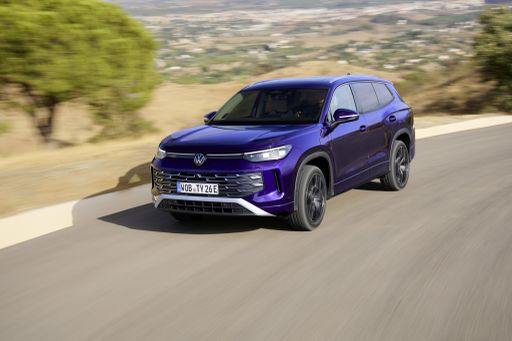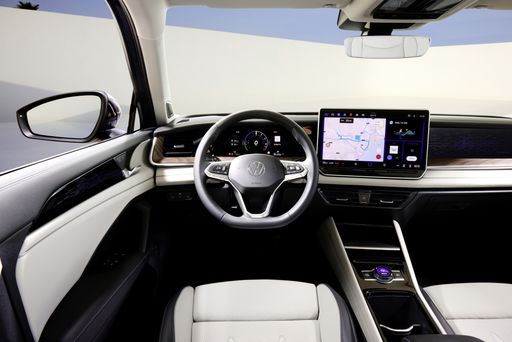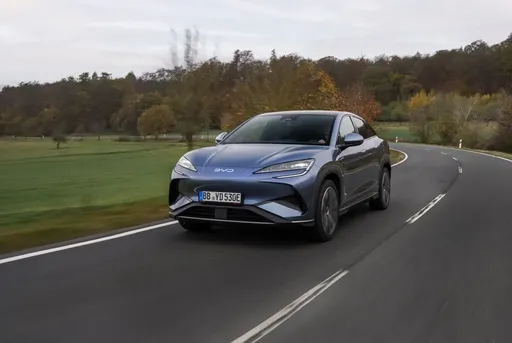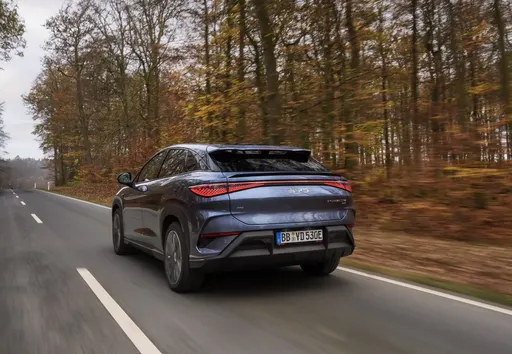VW Tayron vs BYD Sealion 7 – Differences & prices compared
Compare performance, boot space, consumption and price in one view.
Find out now: which car is the better choice for you – VW Tayron or BYD Sealion 7?
The VW Tayron (SUV) comes with a Petrol MHEV, Plugin Hybrid, Diesel or Petrol engine and Automatic transmission. In comparison, the BYD Sealion 7 (SUV) features a Electric engine with Automatic transmission.
When it comes to boot capacity, the VW Tayron offers 885 L, while the BYD Sealion 7 provides 520 L – depending on how much space you need. If you’re looking for more power, decide whether the 272 HP of the VW Tayron or the 530 HP of the BYD Sealion 7 suits your needs better.
In terms of consumption, the values are 0.40 L per 100 km for the VW Tayron, and 19.90 kWh for the BYD Sealion 7.
Price-wise, the VW Tayron starts at 39000 £, while the BYD Sealion 7 is available from 42800 £. Compare all the details and find out which model fits your lifestyle best!
VW Tayron
The Tayron stands out as a stylish and versatile SUV that expertly blends form and function. With its spacious interior and modern design, it caters to families and adventure seekers alike, making every journey enjoyable. Equipped with advanced technology and safety features, the Tayron promises a driving experience that is both secure and exhilarating.
details @ volkswagen-newsroom.com
@ volkswagen-newsroom.com
 @ volkswagen-newsroom.com
@ volkswagen-newsroom.com
 @ volkswagen-newsroom.com
@ volkswagen-newsroom.com
 @ volkswagen-newsroom.com
@ volkswagen-newsroom.com
BYD Sealion 7
The Sealion 7 captivates with its striking design and impressive performance that appeals to both enthusiasts and casual drivers alike. With a focus on comfort and advanced technology, this model redefines the driving experience, making every journey enjoyable. Its sleek silhouette coupled with an innovative interior showcases the perfect blend of style and functionality.
details @ BYD
@ BYD
 @ BYD
@ BYD
 @ BYD
@ BYD

|

|
|
|
|
Costs and Consumption |
|
|---|---|
|
Price
39000 - 52600 £
|
Price
42800 - 52300 £
|
|
Consumption L/100km
0.4 - 8.5 L
|
Consumption L/100km
-
|
|
Consumption kWh/100km
-
|
Consumption kWh/100km
19.9 - 21.9 kWh
|
|
Electric Range
117 - 126 km
|
Electric Range
456 - 502 km
|
|
Battery Capacity
19.70 kWh
|
Battery Capacity
-
|
|
co2
9 - 192 g/km
|
co2
0 g/km
|
|
Fuel tank capacity
45 - 58 L
|
Fuel tank capacity
-
|
Dimensions and Body |
|
|---|---|
|
Body Type
SUV
|
Body Type
SUV
|
|
Seats
5
|
Seats
5
|
|
Doors
5
|
Doors
4
|
|
Curb weight
1682 - 1948 kg
|
Curb weight
2225 - 2435 kg
|
|
Trunk capacity
705 - 885 L
|
Trunk capacity
520 L
|
|
Length
4792 mm
|
Length
4830 mm
|
|
Width
1853 - 1866 mm
|
Width
1925 mm
|
|
Height
1666 - 1668 mm
|
Height
1620 mm
|
|
Payload
489 - 566 kg
|
Payload
410 kg
|
Engine and Performance |
|
|---|---|
|
Engine Type
Petrol MHEV, Plugin Hybrid, Diesel, Petrol
|
Engine Type
Electric
|
|
Transmission
Automatic
|
Transmission
Automatic
|
|
Transmission Detail
Dual-Clutch Automatic
|
Transmission Detail
Reduction Gearbox
|
|
Drive Type
Front-Wheel Drive, All-Wheel Drive
|
Drive Type
Rear-Wheel Drive, All-Wheel Drive
|
|
Power HP
150 - 272 HP
|
Power HP
313 - 530 HP
|
|
Acceleration 0-100km/h
6.1 - 9.7 s
|
Acceleration 0-100km/h
4.5 - 6.7 s
|
|
Max Speed
204 - 240 km/h
|
Max Speed
215 km/h
|
|
Torque
250 - 400 Nm
|
Torque
380 - 690 Nm
|
|
Number of Cylinders
4
|
Number of Cylinders
-
|
|
Power kW
110 - 200 kW
|
Power kW
230 - 390 kW
|
|
Engine capacity
1498 - 1984 cm3
|
Engine capacity
-
|
General |
|
|---|---|
|
Model Year
2025
|
Model Year
2024
|
|
CO2 Efficiency Class
E, B, F, G
|
CO2 Efficiency Class
A
|
|
Brand
VW
|
Brand
BYD
|
VW Tayron
Introducing the VW Tayron: Where Innovation Meets Performance
The VW Tayron is making waves in the SUV market with its cutting-edge technology, impressive performance specifications, and versatile engine options, catering to a diverse range of drivers. As a compact SUV, the Tayron perfectly balances functionality and style, making it an attractive choice for both urban and adventurous lifestyles. Let's dive into the technical aspects and innovations that set the Tayron apart.
Engine Options and Performance
The Tayron is available in several configurations, each engineered to deliver a thrilling driving experience. Among the most notable is the 1.5 eTSI OPF Petrol MHEV engine, boasting an output of 150 horsepower. This variant showcases a superb balance between power and efficiency, achieving an impressive fuel consumption of just 6.2 liters per 100 kilometers.
Additionally, the Tayron offers hybrid options, such as the 1.5 eHybrid OPF Plugin Hybrid. This model can produce up to 204 horsepower, with an electric range of 126 kilometers, allowing drivers to experience the benefits of electric motoring without sacrificing performance. For those who prefer diesel, the 2.0 TDI SCR Diesel engine delivers a robust 193 horsepower, paired with either front-wheel or all-wheel drive configurations. This versatility ensures that there's a suitable option for every type of driver.
Cutting-Edge Technology and Features
The Tayron is equipped with an array of advanced technologies designed to enhance comfort, safety, and connectivity. Its automatic transmission features a dual-clutch system, providing smooth gear shifts and optimal power delivery. The vehicle's driving dynamics are further improved by the availability of Dynamic Chassis Control, allowing drivers to select their preferred driving mode for any given scenario.
Inside, the Tayron boasts a spacious cabin with ample seating for five, complemented by modern design elements and high-quality materials. The trunk capacity reaches up to 885 liters, making it ideal for family outings or long road trips. Furthermore, the integration of the latest infotainment system ensures that drivers remain connected on the go, offering seamless smartphone compatibility through Apple CarPlay and Android Auto.
Safety Comes First
Safety is paramount in the Tayron's design. Equipped with state-of-the-art driver assistance systems, the SUV helps prevent accidents and enhances overall road safety. Features such as adaptive cruise control, blind-spot monitoring, and lane-keeping assist are just some of the innovative safety elements offered in the Tayron. With its comprehensive safety suite, the Tayron provides peace of mind for both drivers and passengers alike.
A Sustainable Future with the Tayron
As environmental awareness continues to grow, the VW Tayron contributes to a more sustainable future through its hybrid variants that feature lower emissions. For instance, the 1.5 eHybrid OPF Plugin Hybrid achieves a CO2 efficiency class of B, demonstrating VW’s commitment to eco-friendly mobility without compromising performance. This shift toward sustainability is becoming increasingly significant for consumers looking for responsible yet fun driving experiences.
Conclusion: The VW Tayron Stands Out
The VW Tayron is a remarkable SUV that encapsulates the perfect blend of performance, technology, and sustainability. With its diverse range of engine options, advanced features, and focus on safety, it is tailored to meet the needs of modern drivers. Whether you opt for the petrol, diesel, or hybrid model, the Tayron is sure to impress with its dynamic capabilities and stylish design, solidifying its place in the competitive automotive landscape.
BYD Sealion 7
The automotive landscape is evolving faster than ever, and one model capturing significant attention is the BYD Sealion 7. This electric SUV not only marries performance with sustainability but also boasts innovations that redefine user expectations. Let’s dive into the technical aspects and standout innovations of this remarkable vehicle.
Powerful Performance and Versatile Configurations
The BYD Sealion 7 comes in several configurations, catering to diverse performance needs. It offers two versions of electric all-wheel drive, producing an impressive 530 horsepower, while the rear-wheel drive variant delivers a solid 313 horsepower. This spectrum of power allows drivers to select an option that aligns with their driving style and requirements.
Acceleration is another noteworthy aspect of the Sealion 7. The rear-wheel drive model achieves 0-100 km/h in just 6.7 seconds, while the all-wheel drive variant does it in a breathtaking 4.5 seconds. This combination ensures that the Sealion 7 doesn’t just compete; it leads in performance within its segment.
Innovative Electric Drive and Efficiency
Equipped with a cutting-edge reduction gearbox, the BYD Sealion 7 not only delivers incredible acceleration but also underscores efficiency with a consumption rate as low as 19.9 kWh per 100 km for the most efficient model. The all-wheel drive variants have slightly higher consumption rates of 21.4 kWh and 21.9 kWh, respectively, but they still perform admirably when it comes to efficiency.
In terms of electric range, the Sealion 7 showcases a commendable performance. Depending on the specific configuration, it offers ranges between 456 and 502 km on a single charge, making it a competitive choice for those concerned about range anxiety typical of electric vehicles.
Sleek Design and Practicality
Beyond performance and efficiency, the BYD Sealion 7 impresses with its aesthetic appeal and practicality. With dimensions of 4830 mm in length, 1925 mm in width, and 1620 mm in height, this SUV is designed for presence. Moreover, the spacious interior comfortably accommodates up to five passengers, enhancing its usability for families and adventure seekers alike.
Practical features like a trunk capacity of 520 liters ensure that the Sealion 7 stands ready for any journey, whether it’s a weekend road trip or daily commuting. Additionally, the vehicle has a payload capacity of up to 410 kg, providing flexibility for carrying cargo without sacrificing comfort.
Safety and Eco-Friendliness
The BYD Sealion 7 also excels in safety and sustainability. It holds a CO2 efficiency class of A, making it an environmentally friendly option with zero emissions during operation. This aligns with the growing consumer demand for greener transportation solutions.
Furthermore, the vehicle is engineered with multiple safety features that ensure a secure driving experience for all occupants, a crucial element that underscores the ongoing commitment by BYD to safety in electric vehicles.
Final Thoughts
As an emblem of electrification in the automotive industry, the BYD Sealion 7 stands out with its combination of powerful performance, innovative technology, and eco-friendly credentials. For those exploring the electric SUV market, this vehicle represents a significant milestone, offering a compelling argument for drivers looking to transition to a more sustainable yet thrilling driving experience.
Which drive types are available for the VW Tayron?
Available as .
The prices and data displayed are estimates based on German list prices and may vary by country. This information is not legally binding.
